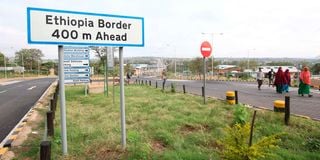Smugglers at Kenya-Ethiopia border stashing drugs inside animals

A signpost in Moyale near the Kenya-Ethiopia border in a picture taken on March 14, 2018. Livestock transporters on the Moyale-Nairobi highway are using animals to smuggle bhang from Shashamane in Ethiopia into the country.
Livestock transporters on the Moyale-Nairobi highway are using animals to smuggle bhang from Shashamane in Ethiopia into the country.
The transporters are reportedly smuggling the drug by putting them inside the animals or in panels placed underneath their lorries.
This was revealed at the start of a stakeholder consultative meeting attended by Interior Principal Secretary Raymond Omollo, Inspector General of Police Japhet Koome, National Authority for the Campaign Against Drugs and Substance Abuse (Nacada) boss Victor Okioma, Ministry of Health officials, regional commanders and representatives from the Kenya Revenue Authority (KRA), Kenya Bureau of Statistics (Kebs), Anti-Counterfeit Authority (ACA) and county governments.
“We have Christmas coming up and then of course the new year and there is expectation that there will be a spike in substance abuse, hence the need for the various teams convening today to come up with measures and mechanisms of ensuring that we have this under control. This includes issues around compliance so that we have facilities selling alcohol properly licensed and measures of quality control put in place,” said Dr Omollo.
The meeting is meant to plan a nationwide crackdown on illicit drugs and counterfeit alcohol during the festive season.
The official said the crackdown is not aimed at making the sale of alcohol difficult, but to ensure that it is conducted within the law.
“The government is not against legitimate alcohol business. Licensed trade in legitimate alcohol is an important economic activity that will be accorded the necessary support and security,” added the PS, who also called on county governments to be firm in their liquor licensing mandate, which is key in the fight against sale of counterfeit alcohol.
The meeting will also review a Nacada report on the spread of the drugs being abused and their effects, as well as assess the outcome of the crackdown that was carried out about six months ago.
“One of our major concerns currently is the influx of cannabis from Shashamane in Ethiopia through Moyale, Wajir, Isiolo and Nairobi to Mombasa. It’s a big challenge and we have had a number of meetings with the security teams in that region trying to map out the routes they are using and I must say we have seen lots of progress in terms of curtailing the influx,” said Mr Okioma.
He added: “Sometimes they will come like they are carrying goats and they have certain provisions for those drugs. This is the kind of information we want to share with the officers.”
According to Nacada, emerging trends in drugs and substance abuse also show that Kenyans are mainly abusing alcohol, tobacco, miraa (khat) and cannabis in that order, all of which have been directly or indirectly linked to some cases of mental illness in the country.
The authority is currently validating its survey on the status of alcohol abuse in the country, which is done every five years, ahead of its release to the public.
An assessment done last year revealed that diazepam, which is highly addictive, benzhexol (artane), flunitrazepam (rohypnol), amitriptyline, chlorpromazine (largactil) and codeine were the most commonly abused prescription drugs in Kenya, mainly by persons aged between 10 and 35 years. Others were carbamazepine, tramadol, chlorpheniramine, benadryl, haloperidol, propofol and olanzapine.
Heroin was found to be commonly abused in counties such as Nakuru, Kiambu, Uasin Gishu, Kisumu, Kiambu and Isiolo, and its demand in the country is growing.
Other substances that the authority has encountered are yet to be identified and have been referred to the Government Chemist for analysis.
Twenty-three counties, most of them in Central, Rift Valley, Western, Nyanza and the Coast regions were found to have high levels of drug abuse.
Scale up the fight
After the meeting taking place at the Kenya Institute for Curriculum Development, regional commissioners are expected to form multi-agency teams to scale up the fight within their regions and address the proliferation of substandard alcohol and illicit brews, sale of alcohol to minors and in residential areas, non-adherence to Covid-19 protocols and liquor licensing challenges.
Mr Koome warned that drink-driving and speeding during the festive season will not be tolerated.
“That excitement that is seen in the month of December, then we start having accidents all over, will not be allowed. Last night we lost nine lives in Nakuru because of carelessness, somebody driving on the wrong side of the road. Let us avoid that excitement,” said the IG.





